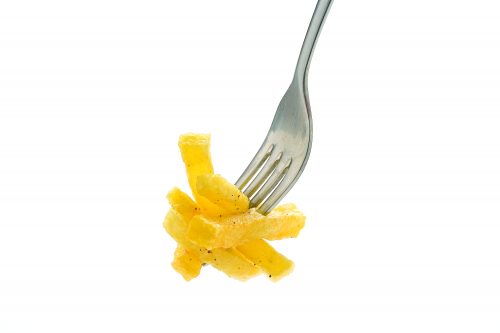
You may think hot chips would be a no-no from a health perspective. But HFG senior nutritionist Rose Carr is pleasantly surprised by some shop-bought frozen potato varieties.
These days, convenience can often be the name of the game when it comes to dinner. And with the wide variety of frozen potatoes on offer, consumers aren’t starved for choice.
What’s available
Peeled, sliced or cubed, ready-cut chips, wedges, roasted and mashed are simpler frozen potato choices – some boasting interesting flavours.
Unfortunately, the further away from the plainer products potatoes get, the more saturated fat and sodium seems to be added. Curly fries and mini hash browns, for example, are not everyday foods.
Nutrition
Potatoes contain vitamin C and because New Zealanders eat quite a few potatoes, we get around 30 per cent of our vitamin C intake from this vege. Potatoes are also a source of carbohydrate, protein, fibre, B vitamins, antioxidants and potassium. In their natural state potatoes are low in sodium and virtually fat-free. What’s added to potatoes can make a big difference to their overall nutrition.
Energy
If a plain potato had a nutrition information panel on it, per 100g it would have 280kJ to 370kJ before oil, and around 390kJ to 480kJ after adding oil. We found many frozen potato products were much higher than this. We recommend choosing products with 600kJ or less per 100g. That’s up to 900kJ in a 150g serve.
Saturated fat
Potatoes don’t contain saturated fat, and we get more than enough in other foods, so it is important to choose products with the least amount of added saturated fat. Aim for products with 2g or less saturated fat per 100g. There are plenty within this range.
Sodium
Less is more when it comes to sodium, but some of the seasoned potato products are pretty high. McCain Seasoned Mini Hash Browns get the thumbs down on all counts: with 933kJ, 2g saturated fat and 600mg sodium per 100g we think these have no place on a dinner plate. The best products we tried don’t have added salt and have less than 50mg sodium per 100g. For seasoned products we recommend choosing those with 400mg sodium or less per 100g.
Fibre
Although fibre doesn’t have to be stated on the nutrition information, products with the skin still on the potato will be higher in fibre and more nutritious.
The bigger picture
Don’t forget the carbohydrate portion of a meal is only one-quarter of the ‘ideal plate’ (protein the other quarter and the remaining half, low-energy vegetables). For example, a lean steak served with 150g of potatoes at 900kJ (600kJ per 100g) and mixed vegetables provides a balanced meal with around 2100kJ without overdoing the fat or sodium. If the other portions on your plate are higher in energy, you may want to choose a lower-kilojoule potato.
www.healthyfood.com










